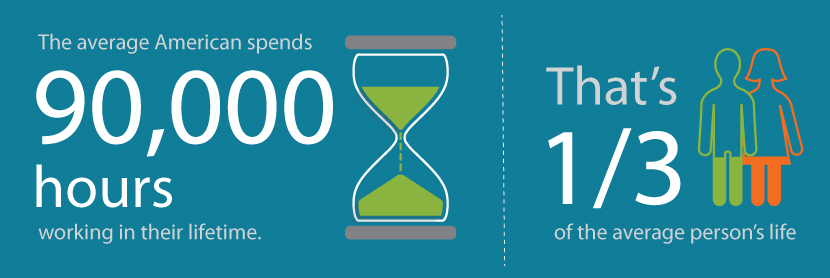Here’s a sobering statistic: On average, Americans spend 90,000 hours at work in their lifetime. That equates to approximately ⅓ of the average person’s life.
With so much time spent at work, it isn’t a surprise that people are constantly frustrated and looking for something new. But as we’ve noted before, just switching companies or positions within your own organization isn’t a panacea for happiness. Sometimes we need to think about what really makes us happy at work and ensure that we are actively pursuing those activities.
This blog post is all about a simple way to take stock in what makes you happy at work, and how to take initiative to pursue options to keep those “happy” activities flowing. Here’s how:
STEP ONE: Assess What Makes You Happy
This seems simple, but we are constantly surprised at how many people we interact with who do not have a strong notion of why they are happy or unhappy with their work. They usually can quickly tell you about their level of happiness with their boss, their team, their peers, etc. – but rarely is the “happiness” flashlight shining on their actual work. To appropriately shine that light in the right place, we ask you to answer the following questions thoughtfully and honestly:
- In the last 5 years, name at least 5 different projects/initiatives that you were working on that really brought you satisfaction/happiness at work.
Time To Dig In And Think: For each of those projects/initiatives, take the time to think about what activities you were specifically doing that equated to satisfaction/happiness. Get as detailed as possible.
- Now think about the type of role you were playing in those projects that led to satisfaction.
- Maybe it was producing a presentation.
- Or giving a presentation.
- Or solving a difficult challenge.
- Or learning a new skill.
Time To Dig In And Think: Across all 5+ projects/initiatives, what roles keep coming to the surface? - The final step is thinking about “why” these types of activities and roles make you happy.
- It could be wanting to be seen as an expert or leader
- It could be wanting to be seen as a “go-getter”
- Or maybe you want to be seen as a methodical thinker.
Time To Dig In And Think: This can help you see where you are in the zone, and how you ultimately want to be perceived by others. (And where being brutally honest with yourself is important!)
STEP TWO: Applying These Insights to Your Work Life
Now that you’ve done the research, it’s time to find new projects and initiatives that will bring some “spark” to your life at work.
While people talk about passion projects, and sometimes wait around for months or years to have an opportunity be assigned to them, real leaders don’t wait around. Other leaders also value initiative from their colleagues. So raising your hand to tackle something that will bring you happiness can also be a win for your own leader/team.
We suggest that you be honest with your team and/or boss. Say something like:
- “I’m really interested in <this>. It brings me passion and I excel at it.
- I’d like to see if there are some opportunities within the team where people would like help with <this>. I’m ready to step up and show my enthusiasm.”
If there aren’t direct or obvious options to showcase that skill on your direct team, don’t hesitate to reach out to your own leader to see if that skill/interest can be utilized in a broader context with another department or group. You’d be surprised how these types of conversations can unexpectedly open doors to new assignments, future job changes, and future development for you.
The only thing holding you back – is you.
We recommend that you do an honest assessment of your own areas of hidden happiness, and waste no time trying to apply them in the tens of thousands of hours of work time that might be ahead of you in your career.
Contact Us Today
We make it easy to jump start success. Simply contact us and share your current team challenge or need, and we’ll respond with program ideas to innovate your team performance.


